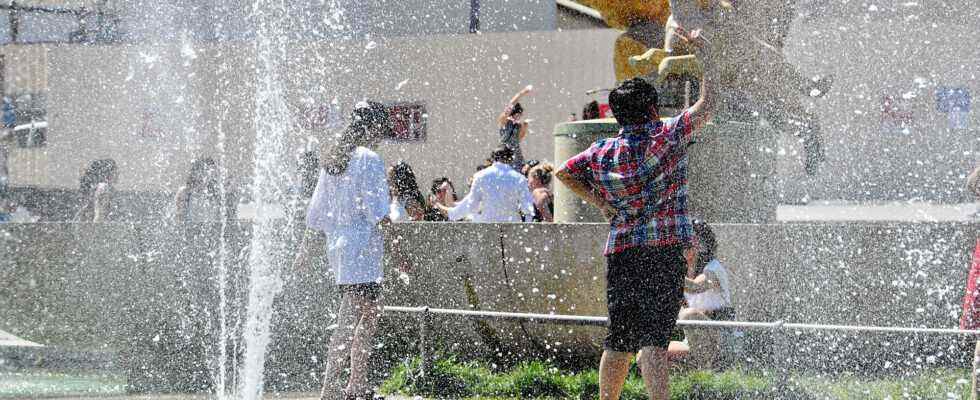The heat wave is spreading, now affecting almost all of France, and two additional departments were placed on red alert on Friday, or 14 in total in the southwestern third of the country.
The Pyrénées-Atlantiques and the Hautes-Pyrénées went into the red, adding to the 12 other departments of the South-West placed at this level of alert Thursday by Météo-France. A total of 56 departments, from the Paris region to the German border as well as from Brittany to the Lyon region, were on orange alert on Friday.
Read also: The earth is dying of thirst: the warning cry of French peasants
Monthly temperature records were reached or beaten on Friday, Météo-France announced. The thermometer climbed to 37.3°C in Millau, beating the previous record of June 2019. In Carcassonne (Aude) the mercury rose to 40.4°C, against 39.8°C on June 21, 2003, and to Cognac 38.9°C against 38.2°C on June 30, 1952.
Read also: “The concentration of particles in the air twice as high near the metro’s air vents”
Météo-France warns that “Saturday afternoon, the heat will increase further on the South Aquitaine, Poitou-Charentes-Vendée axis with therefore rising maximum temperatures”. “Absolute records could then fall,” according to the latest bulletin.
Faced with this leaden screed which covers almost all of the metropolitan territory, the Minister of Health Brigitte Bourguignon visited Friday morning in Vienne an Ehpad, where she exchanged with some residents.
“We are in a very early episode of heat wave, a strong episode which lasts a little longer than expected”, she declared to the press, adding that “the hospital is obviously saturated, but responds to demand”.
Precautions
During the electoral campaign in Calvados, Prime Minister Elisabeth Borne insisted on the instructions for caution and prevention for vulnerable people. “The urgency is really these instructions on how to be careful with these hot weather which will last until the end of the week”, she underlined.
Red vigilance, the highest level of the “national heat wave plan”, concerns 12 other departments: Charente, Charente-Maritime, Haute-Garonne, Gers, Gironde, Landes, Lot-et-Garonne, Deux-Sèvres, Tarn, Tarn- et-Garonne, Vendée and Vienne.
Schoolchildren and college students in these areas could stay at home on Friday.
In the academy of Bordeaux, only 30 to 50% of the pupils were present in the primary schools of Gironde, one out of two in the Lot-et-Garonne, up to 75% in the Landes, indicated the rectorate, specifying that ‘no establishment has closed.
In Haute-Saône, ten students aged 10 and 11 were victims of heatstroke after playing on a multi-sports ground near their school in Pin, where the temperature reached 35°C. They were medicalized on the spot by the firefighters, according to the mayor.
In addition, tourists changed their program. “Basically I love walking, I wanted to visit Bordeaux. But here we can’t walk, I take the tram, I don’t do what I would have liked to do”, regrets Nicole Taveneau, who came from Vendée and who takes advantage shade in the public garden.
“I might have done a museum, but not as much! There, I visited four or five in three days,” she explains to AFP.
The next night, the hottest night
The night from Friday to Saturday, “the hottest of the” heatwave episode which started on Tuesday, should be a test, with minimums not dropping below 21 to 26°C in the most affected departments. On Saturday, peaks of 42°C will be possible locally towards the south of Aquitaine, adds Météo-France
At Château-d’Oléron, one of the eight towns on the Ile d’Oléron, it is certainly “only” 37°C in the afternoon, but customers shun the shaded terraces.
Normally, at lunchtime, “the terrace is full, but it’s hot there”, breathes Cyrille Sauvage, owner of the Café du Port.
Although accustomed to high heat, the inhabitants of the Pyrénées-Orientales must also adapt.
“I attack at daybreak until 11:30 a.m., and then I can work in the evening, before nightfall,” says Daniel Toffaloni, 64, a farmer near Elne. In his greenhouses where he grows tomatoes, the temperature can reach 55°C in the afternoon.
In the Centre-Val de Loire region, it is on the Indre-et-Loire that the heat wave weighs the most. Harvest fires are increasing there, with 20 hectares of fields going up in smoke, mobilizing a hundred firefighters.
This department has become a “very severe” fire risk, like Haute-Vienne, and the prefecture has banned agricultural work from 12:00 p.m. to 5:00 p.m. Friday and Saturday, in order to avoid harvest fires.
In Charente-Maritime, the Free Music festival, scheduled for this weekend, is canceled by prefectural decision, like all cultural, recreational or sports gatherings outdoors, outside markets, in the region’s red classified departments.
With the heat, the concentrations of ozone in the air are clearly increasing over a large part of France, according to the official bulletin Prev’Air, which predicts that they will remain high “in the days to come”.
